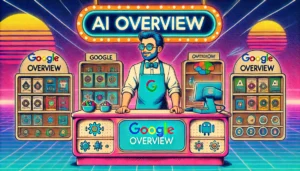How Will Websites Look in an AI-Dominated Era?
As AI technology becomes more accessible, websites are poised for a radical shift—less scrolling through static pages and more interactive, real-time conversations. In this article, we’ll explore how these AI-driven sites work, why knowledge bases and chatbots are essential, and how your business can thrive in an AI-dominated era. If you’re aiming to offer a
Websites have come a long way from simple online brochures to interactive platforms for sales, services, and support. But if you’ve been paying attention to technological shifts, there’s a whole new wave coming—one dominated by artificial intelligence (AI). In the next five years, experts predict websites will transform into more conversational, dynamic, and tailored experiences for each visitor. You won’t just be scrolling through pages and clicking links; you’ll be talking to an intelligent agent, getting personalized results, and engaging with content that adapts to your needs in real time.
For many business owners, this can sound both exciting and a bit daunting. How exactly will these AI-driven sites work? Will they require a complete overhaul of your current website? And what benefits can you expect? Let’s dive into the world of AI-dominated websites—and why they’re poised to reshape the internet as we know it.
From Traditional Navigation to Interactive Conversations
Right now, most websites are designed with a clear navigation path. You have a menu at the top, sections of content below, and links guiding you toward the information you (or the site’s owner) want to highlight. But in an AI-first future, websites may start looking (and feeling) more like interactive experiences.
Instead of hunting around for a small FAQ link buried in the footer, you might just see a friendly chatbot pop up, saying: “Hey, what do you need today?” And it won’t be some generic, pre-scripted chatbot. These bots will be connected to powerful knowledge bases that can answer detailed questions about your product, service, or even industry trends. If that sounds a bit futuristic, you can already see the seeds of it in many modern chatbots, as discussed in Chatbots on Websites Have Always Been Around, What’s Different Now in 2025?.
Building Knowledge Bases & Training Chatbots
A big part of creating an AI-driven website is developing a robust knowledge base—a sort of digital library that the chatbot or AI assistant can tap into to answer user questions. If your business has manuals, customer FAQs, blog articles, product data, or even transcripts from real support interactions, you can feed that information into the chatbot’s “brain.”
- Collect Your Content: Gather user guides, service guidelines, common issues, etc.
- Organize & Tag: Make sure everything is labeled properly so the AI can quickly find relevant details.
- Train the AI: This means running the data through AI models, ensuring they understand not just the words, but the context (how a customer might ask a question, synonyms, typical follow-ups).
- Iterate & Refine: Monitor the chatbot’s responses. Tweak and add to the knowledge base as new questions arise.
The end result? Visitors can ask your website just about anything—“How do I reset my password?” or “Which product is best for me if I have a small budget?”—and get accurate, context-rich answers within seconds.
For a deeper look at how businesses can map their journey from initial AI adoption to full operational excellence, check out 5 Critical Stages of Business AI Transformation: From Customer Experience to Operational Excellence. It breaks down the phases of leveraging AI for better user engagement and backend efficiency.
Personalized User Journeys
The future of websites isn’t just about responding to users; it’s also about proactively customizing what they see, read, and experience. AI algorithms can analyze a visitor’s behavior in real time—looking at what pages they spend the most time on, which products they add to a cart, or even their geographical location—and tailor the website to fit that data.
- Relevant Recommendations: Someone interested in marketing software could see case studies from their industry at the top of the homepage.
- Adaptive Layouts: A visitor from the U.K. might be greeted with currency options in pounds, while someone from Canada gets a different currency by default.
- Smart Promotions: If a user has read multiple articles about a particular service, an offer or discount might pop up specifically for that service.
In short, these sites feel less like static pages and more like conversations, remembering your preferences and anticipating your needs. Getting started with these strategies is easier than ever; if you’re worried about the complexity of AI tools, 7 Smart Steps to Start Your Business AI Transformation Without Getting Overwhelmed offers clear, manageable steps to begin integrating AI into your existing workflow.
A Glimpse Five Years Ahead
Now let’s jump to the near future—five years from now. Websites as we know them might feel almost outdated. Navigation bars could be optional instead of mandatory. The homepage could be replaced by a single, AI-driven interface where you type or speak your question.
Imagine logging onto a retail website looking for a new pair of running shoes. Instead of browsing pages of product listings, you might simply ask, “I have flat feet and I run on trails—what’s the best shoe for me?” The site’s AI agent, using a robust knowledge base and product data, would instantly show you curated options, complete with user reviews or even advice from running experts.
The entire experience becomes more fluid, intuitive, and frictionless. It’s almost as if you have a personal shopper or consultant inside the screen, guiding you instantly. And that same approach can apply across industries—finance, healthcare, education, or even government services.
For more insights on preparing your business for 2025 and beyond, How to Transform Your Business for AI: A Practical Guide for 2025 explores the mindset and tools you’ll need to stay competitive in a rapidly changing online environment.
The New Role of Content & Design
Many business owners worry that if AI takes over user interactions, “Do I even need web design or content anymore?” The answer is a resounding yes—they just might take on new forms.
- Conversational Copywriting: Instead of writing purely for static web pages, content creators will focus on how the AI “speaks” to users, ensuring it matches your brand’s tone and style.
- Adaptive Design: Even if the main interface is a chatbot or voice assistant, you’ll still need a coherent design for support content, visuals, and brand identity.
- Micro-Interactions: Buttons, animations, and small design details will guide visitors to engage further with AI-driven elements.
Ultimately, design and content become the supporting cast for your site’s AI star—making sure everything runs smoothly and remains visually appealing.
Overcoming Fears & Embracing Change
Adopting AI can feel overwhelming, especially if you’re used to a more traditional approach to website development. There are concerns about data privacy, tech complexity, and of course, cost. But staying put might be riskier in the long run, as consumer expectations evolve rapidly.
If you’re still in doubt, remember that you can start small: add a knowledge base, experiment with an AI chatbot on your FAQ page, or try personalized product recommendations. 5 Critical Stages of Business AI Transformation (mentioned earlier) and 7 Smart Steps to Start Your Business AI Transformation Without Getting Overwhelmed both show you exactly how you can pace your journey without diving in headfirst.
Action Steps: Your AI-Ready Roadmap
- Assess Your Content: Gather FAQs, guides, blogs—anything that can train a bot.
- Choose an AI Tool: There are plenty of AI platforms that integrate into existing websites.
- Test & Tweak: Launch in beta, get real feedback, and refine.
- Plan for Growth: As your knowledge base expands, so will your AI’s capabilities—be ready for the next level.
- Stay Adaptable: In technology, only those who are quick to adapt are able to keep up with the ever-changing landscape of the World Wide Web.
The future is bright for businesses that embrace AI-driven user experiences. By taking these steps now, you’ll position your website—and your brand—for whatever comes next.
Websites in an AI-dominated era will look less like the static pages we’re used to and more like interactive, personalized hubs where visitors converse with an intelligent agent. The shift is already happening, and in the next five years, it’s poised to become the norm. Whether you’re a small business owner or a marketing pro, staying ahead means preparing for this conversational, hyper-personalized world.Ready to explore how AI can transform your website? Contact us for a Smart Site demo (Smart Sites are websites with AI integration), and we’ll show you exactly how you can build a dynamic online presence your customers will love.








